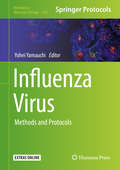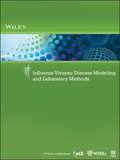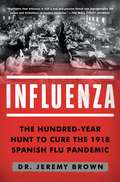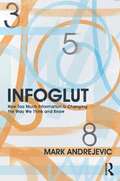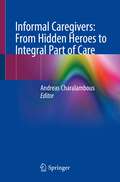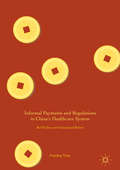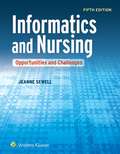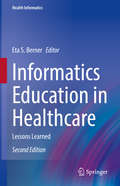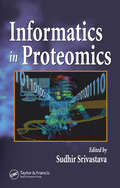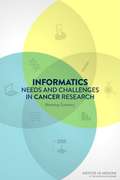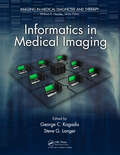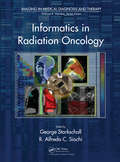- Table View
- List View
Influenza Virus: Methods And Protocols (Methods in Molecular Biology #1836)
by Yohei YamauchiThis book provides researchers with widely used techniques for the study of virology, focusing on molecular biology and imaging to encourage mechanistic investigation of virus-host interactions. Chapters detail a broad range of methods from diagnosis, virus propagation, proteomics, haploid screening, lentiviral screening, virus entry, single molecule RNA imaging, correlative light and electron microscopy (CLEM), EM, light-sheet microscopy, biochemistry, viral transcription, physiological infection models, animal models, in vivo imaging, antigenic evolution, immunology to mathematical modelling. Reviews cover general influenza, clinical trials, both sides of the gain-of-function debate, and computational modelling. Written in the highly successful Methods in Molecular Biology series format, chapters include introductions to their respective topics, lists of the necessary materials and reagents, step-by-step, readily reproducible laboratory protocols, and tips on troubleshooting and avoiding known pitfalls. Cutting-edge and thorough, Influenza Virus: Methods and Protocols aims to motivate experienced researchers and newcomers in the field and improve our overall understanding of influenza.
Influenza Viruses: Disease Modeling and Laboratory Methods (Life Science Research Fundamentals)
by WileyInfluenza virus infections are a serious health problem. Each year, about 500 million people are infected by the virus, resulting in about 500,000 deaths worldwide. The occurrence of new influenza subtypes has caused severe pandemics, including the 2009 swine flu (vH1N1). In addition, highly pathogenic viruses, like subtypes H7N7 and H5N1, also called the fowl plague and bird flu, respectively, represent enormous economic threats to livestock farming. This book begins with descriptions of the molecular make-up of influenza viruses, their replication cycles and functions of viral proteins. A history of major influenza pandemics is provided as is a detailed article discussing how viral growth and decay is mathematically modeled to evaluate the biological parameters governing interaction between host and virus. Several laboratory protocols describe how influenza virus is handled and used in animal models to study host-pathogen interactions and test potential new therapies. This e-book — a curated collection from eLS, WIREs, and Current Protocols — offers a fantastic introduction to the field of influenza research for students or interdisciplinary collaborators.
Influenza and Public Health: Learning from Past Pandemics (The\earthscan Science In Society Ser.)
by Susan Craddock Jennifer Gunn Tamara Giles-VernickMajor influenza pandemics pose a constant threat. As evidenced by recent H5N1 avian flu and novel H1N1, influenza outbreaks can come in close succession, yet differ in their transmission and impact. With accelerated levels of commercial and population mobility, new forms of flu virus can also spread across the globe with unprecedented speed. Responding quickly and adequately to each outbreak becomes imperative on the part of governments and global public health organizations, but the difficulties of doing so are legion. One tool for pandemic planning is analysis of responses to past pandemics that provide insight into productive ways forward. This book investigates past influenza pandemics in light of today's, so as to afford critical insights into possible transmission patterns, experiences, mistakes, and interventions. It explores several pandemics over the past century, from the infamous 1918 Spanish Influenza, the avian flu epidemic of 2003, and the novel H1N1 pandemic of 2009, to lesser-known outbreaks such as the 1889-90 influenza pandemic and the Hong Kong Flu of 1968. Contributors to the volume examine cases from a wide range of disciplines, including history, sociology, epidemiology, virology, geography, and public health, identifying patterns that cut across pandemics in order to guide contemporary responses to infectious outbreaks.
Influenza and Respiratory Care
by Mieczyslaw PokorskiRespiratory infections constitute a major public health concern. The goal of this book is to share knowledge on the best advances in influenza and influenza-like viral infections, and new molecular-based diagnostic methods that discern the antigenic shift providing viruses the ability to constantly evolve and elude the host immune response. Co-infections, co-morbidities, persistently meager anti-flu vaccination coverage, and infection complications are dealt with. The chapters also further insight into such topics as the effect of sex hormones, and socioeconomic and anthropometric measures, on respiratory and immune functions underlying the severity of asthma and respiratory allergy. Psychological functioning in respiratory disorders, taking into account quality of life, illness acceptance, and depressive symptoms is also reviewed as it is all too often underestimated by healthcare providers. The book is intended for clinicians, researchers, students, and all other actors in health-related issues.
Influenza: Advances in Diagnosis and Management (Respiratory Disease Series: Diagnostic Tools and Disease Managements)
by Jiro FujitaThis book explores the latest research and practical data on the clinical management of influenza. Starting with the definition, epidemiology and pathogenesis, the first part reviews the basic science of the influenza virus and infection. The next three parts then discusses the diagnosis, complications and management, providing practical data and insights that are useful in day-to-day patient care. The last part focuses on the trending topics, including a new drug, oral baloxavir marboxil, which was introduced in Japan in 2018 and is the first polymerase inhibitor to be licensed for the treatment of uncomplicated influenza. In Japan, since the medical insurance system is well-established, patients receive medical examinations quickly after the onset of influenza viral infection, making it easy to implement early diagnostic tools and early treatment. Providing practical data and insights, Influenza - Advances in Diagnosis and Management is a useful resource for clinicians, residents and trainees around the globe.
Influenza: The Hundred Year Hunt to Cure the Deadliest Disease in History
by Jeremy BrownOn the 100th anniversary of the devastating pandemic of 1918, Jeremy Brown, a veteran ER doctor, explores the troubling, terrifying, and complex history of the flu virus, from the origins of the Great Flu that killed millions, to vexing questions such as: are we prepared for the next epidemic, should you get a flu shot, and how close are we to finding a cure? <P><P>While influenza is now often thought of as a common and mild disease, it still kills over 30,000 people in the US each year. Dr. Jeremy Brown, currently Director of Emergency Care Research at the National Institutes of Health, expounds on the flu's deadly past to solve the mysteries that could protect us from the next outbreak. <P><P>In Influenza, he talks with leading epidemiologists, policy makers, and the researcher who first sequenced the genetic building blocks of the original 1918 virus to offer both a comprehensive history and a roadmap for understanding what’s to come. Dr. Brown digs into the discovery and resurrection of the flu virus in the frozen victims of the 1918 epidemic, as well as the bizarre remedies that once treated the disease, such as whiskey and blood-letting. \ <P><P>Influenza also breaks down the current dialogue surrounding the disease, explaining the controversy over vaccinations, antiviral drugs like Tamiflu, and the federal government’s role in preparing for pandemic outbreaks. Though 100 years of advancement in medical research and technology have passed since the 1918 disaster, Dr. Brown warns that many of the most vital questions about the flu virus continue to confound even the leading experts. <P><P>Influenza is an enlightening and unnerving look at a shapeshifting deadly virus that has been around long before people—and warns us that it may be many more years before we are able to conquer it for good.
Infoglut: How Too Much Information Is Changing the Way We Think and Know
by Mark AndrejevicToday, more mediated information is available to more people than at any other time in human history. New and revitalized sense-making strategies multiply in response to the challenges of "cutting through the clutter" of competing narratives and taming the avalanche of information. Data miners, "sentiment analysts," and decision markets offer to help bodies of data "speak for themselves"—making sense of their own patterns so we don’t have to. Neuromarketers and body language experts promise to peer behind people’s words to see what their brains are really thinking and feeling. New forms of information processing promise to displace the need for expertise and even comprehension—at least for those with access to the data. Infoglut explores the connections between these wide-ranging sense-making strategies for an era of information overload and "big data," and the new forms of control they enable. Andrejevic critiques the popular embrace of deconstructive debunkery, calling into question the post-truth, post-narrative, and post-comprehension politics it underwrites, and tracing a way beyond them.
Informal Caregivers: From Hidden Heroes to Integral Part of Care
by Andreas CharalambousThis book builds on the current trends in informal caregivers’ role in the supportive care of cancer patients (as well as other diseases) across the care continuum covering topics from the healthcare professionals and the users’ perspectives. Informal caregivers are a critical resource to their care recipients and an essential component of the health care system. The book introduces a comprehensive view of the topic and acknowledges the importance and the complexity of caregiving. Here lays one of the uniqueness of this book, which highlights the areas and the ways that for example interventions in specific settings/groups of patients can actually facilitate the caregiving process. The increasing number of care-dependent people, the adoption of the principle “outpatient before inpatient”, the shift of care from inpatient to outpatient and the preference for home care (i.e. majority) are only some of the reasons that contributed to Informal caregiving becoming a central feature of the health care landscape and will become even more prominent in the decades ahead. The book draws on the experts’ high-end, current systematic research evidence and real-life examples on these topics to provide an insightful perspective on undertaking research within this context, and to demonstrate informal caregivers’ impact on patients’ outcomes. The structure of the book provides multiple perspectives to the topic and makes it appealing to a wide range of recipients including the nursing community, clinicians, social workers, researchers, policy makers, technology experts as well as postgraduate students especially to those practicing specifically in supportive care in cancer. The book fills a gap in this field of expertise not only by familiarizing the reader with a wide range of topics to be considered but it also emphasizes on what the developments in the field in the future would need to take into consideration. Finally, current and future studies can be informed from the practices of preceding studies that are incorporated in the book.
Informal Healthcare in Contemporary Russia: Sociographic Essays on the Post-Soviet Infrastructure for Alternative Healing Practices (Soviet and Post-Soviet Politics and Society #165)
by Yulia KrasheninnikovaThis volume deals with one of the most understudied aspects of everyday life in Russian society. Its main characters are the providers of goods and services to whom people turn for healthcare instead of official medical institutions. This encompasses a wide range of actors—from network marketing companies to 'folk' journals on health as well as healers, complementary medicine specialists, and religious organizations.Krasheninnikova's investigation pays particular attention to the legal, social, and economic status of informal healthcare providers. She demonstrates that these agents tend to flourish in bigger towns rather than in small settlements, where public healthcare is lacking. She also emphasizes the flexibility of boundaries between formal and informal healthcare due to the evolution of rules and regulations. The study reveals the important role of institutions that are generally not connected to alternative medicine, such as pharmacies, libraries, and church shops. This book is based on rich empirical observations and avoids both positive and critical assessment of the analyzed phenomena. The result is a vivid and thorough introduction to the world of self-medication and alternative healing in contemporary Russia.
Informal Payments and Regulations in China's Healthcare System
by Jingqing YangThis text addresses the key issue of informal payments, or 'red packets', in the Chinese Healthcare system. It considers how transactions take place at the clinical level as well as their regulation. Analysing the practice from the perspectives of institutions and power structure, it examines how institutional changes in the pre-reform and reform era have changed the power structure between medical professions, patients and the Party-state, and how these changes have given rise and perpetuate the practice. Drawing from qualitative data from interviews of medical professionals, the author recognises the medical profession as a major player in the health care system and presents their perception of the practice as the taker of 'red packets' and their interactions with the patient and the state surrounding the illegal practice in an authoritarian power structure. The books considers the institutional reasons that motivate doctors to take, patients to give, and the government to "tolerate" red packets, arguing that the bureaucratization of the medical profession, society of acquaintances and shortage of quality of medical services jointly create an institutional setting that has given rise to these informal payments. Contributing to a rounded understanding of the problems of healthcare reform in China, this book is a key read for all scholars interested in the issue of informal payments and healthcare politics in transition economies.
Informatics And Nursing: Opportunities And Challenges
by Jeanne SewellInformatics and Nursing: Opportunities and Challenges is a comprehensive informatics text focused on helping the nursing student learn the basics of informatics. The contents proceed from Unit One which covers computer basics to Unit Five which examines skills and techniques for using the end product of informatics: data. The text provides the foundational knowledge to understand technology and use informatics to discover and manipulate information and access, manage, retrieve, and present clinical data. This text was designed to capture cutting-edge advancement in nursing informatics core competencies and applications and to present the theories, tools, and skills that every nurse should know. The new edition has been updated for currency and has had chapters reorganized and consolidated to help students focus on important information.
Informatics Education in Healthcare: Lessons Learned
by Eta S. BernerWith the growth of the use of electronic medical records there has been a concomitant increase in training and education programs in informatics and health IT to prepare individuals as researchers, leaders, managers and developers of informatics tools, intervention and systems. This book will provide both theoretical and practical information for educators in a variety of these programs. We will include the "tacit knowledge" of experienced teachers, which is often not captured in traditional education textbooks. The book would be a blend of strategies, methods and suggested curriculum content. The book is designed to address issues common to all programs as well as education programs for special audiences. The chapter authors are all nationally recognized for their expertise in, and commitment to, informatics education. Although some chapters appear to be addressing specialized areas, there are general lessons to be learned even from those chapters in addition to the chapters that are specifically addressing general issues. The aims of the book are as follows: To address the lack of a broad based book in best practices for informatics education To provide a educational knowledge foundation for informatics educators at all levels To provide specific lessons learned in specialized informatics education areas.
Informatics Education in Healthcare: Lessons Learned (Health Informatics #92)
by Eta S. BernerThis heavily revised second edition defines the current state of the art for informatics education in medicine and healthcare. This field has continued to undergo considerable changes as the field of informatics continues to evolve. The book features extensively revised chapters addressing the latest developments in areas including relevant informatics concepts for those who work in health information technology and those teaching informatics courses in clinical settings, techniques for teaching informatics with limited resources, and the use of online modalities in bioinformatics research education. New topics covered include how to get appropriate accreditation for an informatics program, data science and bioinformatics education, and undergraduate health informatics education. Informatics Education in Healthcare: Lessons Learned addresses the broad range of informatics education programs and available techniques for teaching informatics. It therefore provides a valuable reference for all involved in informatics education.
Informatics In Proteomics
by Sudhir SrivastavaThe handling and analysis of data generated by proteomics investigations represent a challenge for computer scientists, biostatisticians, and biologists to develop tools for storing, retrieving, visualizing, and analyzing genomic data. Informatics in Proteomics examines the ongoing advances in the application of bioinformatics to proteomics researc
Informatics Needs and Challenges in Cancer Research
by Sharyl J. NassAs information technology becomes an integral part of health care, it is important to collect and analyze data in a way that makes the information understandable and useful. Informatics tools--which help collect, organize, and analyze data--are essential to biomedical and health research and development. The field of cancer research is facing an overwhelming deluge of data, heightening the national urgency to find solutions to support and sustain the cancer informatics ecosystem. There is a particular need to integrate research and clinical data to facilitate personalized medicine approaches to cancer prevention and treatment--for example, tailoring treatment based on an individual patient's genetic makeup as well as that of the tumor --and to allow for more rapid learning from patient experiences. To further examine informatics needs and challenges for 21st century biomedical research, the IOM's National Cancer Policy Forum held a workshop February 27-28, 2012. The workshop was designed to raise awareness of the critical and urgent importance of the challenges, gaps and opportunities in informatics; to frame the issues surrounding the development of an integrated system of cancer informatics for acceleration of research; and to discuss solutions for transformation of the cancer informatics enterprise. Informatics Needs and Challenges in Cancer Research: Workshop Summary summarizes the workshop.
Informatics and Nursing: Opportunities And Challenges (Coursepoint For Bsn Ser.)
by Jeanne SewellPublisher's Note: Products purchased from 3rd Party sellers are not guaranteed by the Publisher for quality, authenticity, or access to any online entitlements included with the product. Focusing on the information every nurse should know and capturing cutting-edge advances in a rapidly changing field, this practical text helps students build the communication and information literacy skills they need to integrate informatics into practice. This edition retains the key coverage of the previous edition, including office cloud computing software, interoperability, consumer informatics, telehealth, clinical information systems, social media use guidelines, and software and hardware developments, while offering new information and references throughout. Highlights of the 6th Edition Updated coverage Built-in learning aids Integrated QSEN scenarios Available with CoursePoint for Informatics and Nursing, 6th Edition Combining the world-class content of this text with Lippincott’s innovative learning tools in one easy-to-use digital environment, Lippincott CoursePoint transforms the teaching and learning experience, making the full spectrum of nursing education more approachable than ever for you and your students. This powerful solution is designed for the way students learn, providing didactic content in the context of real-life scenarios—at the exact moments when students are connecting theory to application. Features Create an active learning environment that engages students of various learning styles. Deliver a diverse array of content types—interactive learning modules, quizzes, and more—designed for today's interactive learners. Address core concepts while inspiring critical thinking. Reinforce understanding with instant SmartSense remediation links that connect students to the exact content they need at the precise moment they need it. Analyze results and adapt teaching methods to better meet individual students’ strengths and weaknesses. Empower students to learn at their own pace in an online environment available anytime, anywhere.
Informatics for Health Professionals (Navigate 2 Advantage Access)
by Dee McGonigle Kathleen MastrianNew edition available December 2019! Informatics for Health Professionals is an excellent resource to provide healthcare students and professionals with the foundational knowledge to integrate informatics principles into practice. <P><P>The theoretical underpinning of this text is the Foundation of Knowledge model, which explains how informatics relates to knowledge acquisition, knowledge processing, knowledge generation, knowledge dissemination, and feedback. Once readers understand informatics and the way in which it supports practice, education, administration, and research, they can apply these principles to improve patient care at all levels.
Informatics in Medical Imaging (Imaging in Medical Diagnosis and Therapy)
by Adam Zak Bill WaddellInformatics in Medical Imaging provides a comprehensive survey of the field of medical imaging informatics. In addition to radiology, it also addresses other specialties such as pathology, cardiology, dermatology, and surgery, which have adopted the use of digital images. The book discusses basic imaging informatics protocols, picture archiving and
Informatics in Radiation Oncology (Imaging in Medical Diagnosis and Therapy)
by George StarkschallReflecting the increased importance of the collaborations between radiation oncology and informatics professionals, Informatics in Radiation Oncology discusses the benefits of applying informatics principles to the processes within radiotherapy. It explores how treatment and imaging information is represented, stored, and retrieved as well as how t
Information Discovery on Electronic Health Records (Chapman & Hall/CRC Data Mining and Knowledge Discovery Series)
by Vagelis HristidisExploiting the rich information found in electronic health records (EHRs) can facilitate better medical research and improve the quality of medical practice. Until now, a trivial amount of research has been published on the challenges of leveraging this information. Addressing these challenges, Information Discovery on Electronic Health Records exp
Information Governance for Healthcare Professionals: A Practical Approach (HIMSS Book Series)
by Robert F. SmallwoodLike other critical organizational assets, information is a strategic asset that requires high level of oversight in order to be able to effectively use it for organizational decision-making, performance improvement, cost management, and risk mitigation. Adopting an information governance program shows a healthcare organization’s commitment to managing its information as a valued strategic asset. Information governance serves the dual purpose of optimizing the ability to extract clinical and business value from healthcare information while meeting compliance needs and mitigating risk. Healthcare organizations that have information governance programs will have a competitive edge over others and contributes to safety and quality of care, population health, operational efficiency and effectiveness, and cost reduction initiatives. This is a much-needed book in the healthcare market space. It will explain, in clear terms, how to develop, launch, and oversee an Information Governance program. It also provides advice and insights from leading IG, cybersecurity and information privacy professionals in healthcare.
Information Infrastructures within European Health Care
by Margunn Aanestad Miria Grisot Ole Hanseth Polyxeni VassilakopoulouThis book is open access under a CC BY-NC 2. 5 license. The book aims to be a resource for those interested in planning and implementing large-scale information infrastructures for novel electronic services in health care. The focus of this book is on the pivotal role of the installed base (i. e. the already existing elements of an infrastructure) for ensuing infrastructural development. The book presents rich empirical cases on the design, development and implementation of core infrastructural components (e-prescription and public patient-oriented web platforms) in different national settings across Europe. Therefore, this is a book in which theoretical insights and practical experiences are tightly connected. Contributions have been sourced from a network of academics that have been working on the topic for years, and who have previously collaborated and shared a common understanding of the challenges entailed in expanding information infrastructures within healthcare. The book aims to become a reference for those seeking theoretical and empirical insights for conceptualizing and steering the evolution of information infrastructures in healthcare. The two types of systems (e-prescription and public patient-oriented web platforms) have been selected because they are widespread across Europe, because they invite comparisons, and because they are exemplary of two different types of aims. E-prescription initiatives are usually seen as opportunities to improve healthcare delivery by systematic and not dramatic change. Public patient-oriented web platforms are seen as opportunities to pursue wider and more radical innovation. This book targets researchers, practitioners and students who would benefit from a book providing a comprehensive view to contemporary approaches for the design and deployment of large-scale, inter-organizational systems within healthcare. This book is open access under a CC BY 4. 0 license.
Information Medicine: The Revolutionary Cell-Reprogramming Discovery that Reverses Cancer and Degenerative Diseases
by Ervin Laszlo Pier Mario BiavaA look at the future of medicine based on cutting-edge stem cell research • Shares Dr. Biava’s groundbreaking research on stem cell differentiation stage factors (SCDSFs) as a cellular “reprogramming” treatment for cancer and other degenerative diseases • Explains how SCDSFs restore communication between cells and the epigenetic code, the information that programs the normal function and growth of every living cell • Explores how the universe operates like a cosmic information-network and how this new scientific worldview will shape the future of healing and medicine The universe is not a mechanical system of matter--it operates like a cosmic network that runs on and is connected by information. Information “in-forms” and underlies all of the physical world, including the human body. In this book, Pier Mario Biava, M.D., and Ervin Laszlo, Ph.D., show how this “information” worldview can be applied to healing and medicine and, specifically, how it underlies a revolutionary new approach to cancer and disease treatment, one that works directly with the epigenetic code--the information that programs the function and growth of every living cell. The authors explain how tumor growth and cellular dysfunction are manifestations of disconnections in the information network of an organism. Unveiling Dr. Biava’s groundbreaking research on stem cell differentiation stage factors (SCDSFs), they explain how SCDSFs work directly as epigenetic regulators to reconnect aberrant cells to the body’s information network and reset them to their original function--in the case of cancer cells transforming them from malignant to benign, from dysfunction back to normalcy and health. Dr. Biava’s research on SCDSFs--derived from Zebrafish embryos, which have a very high percentage of proteins identical with those of human beings--has shown good success in reprogramming and inhibiting cancer cells in clinical trials with patients with advanced liver cancer, as well as success in in vitro studies with 7 different human tumor lines. SCDSFs have also shown promise in the treatment of chronic diseases such as psoriasis and neurodegenerative diseases. This research will also allow the development of new treatments for Alzheimer’s, Parkinson’s, and multiple sclerosis. Unveiling the holistic future of medicine, the authors show how we will no longer need to approach the treatment of cancer and other degenerative diseases as a “fight,” but as a restoration of our cells’ original programming. With the advent of Information Medicine, we now have the power to program ourselves to heal.
Information Practices and Knowledge in Health
by Viviane Clavier Céline PaganelliIn the field of health, information practices and the organization of knowledge constitute a major challenge today. The practices of the medical profession, or of patients, are evolving under the influence of digital technology. At the same time, the way in which medical knowledge is organized, represented and mediated is also evolving.Information Practices and Knowledge in Health addresses the different aspects of the field of specialized medical and health information; it focuses on the informational practices of professionals in the sector, of patients and, more broadly, of citizens with regards to their health. This book also considers the systems that are used for organizing knowledge in this field.
Information Privacy in the Evolving Healthcare Environment (HIMSS Book Series)
by Linda KoontzAdvances in health information technology (health IT) have the potential to improve the quality of healthcare, to increase the availability of health information for treatment, and to implement safeguards that cannot be applied easily or cost-effectively to paper-based health records. However, the digitization of health information is also raising new privacy risks and concerns. Sensitive health information in digital form is more easily aggregated, used, and shared. In addition, the rising cost of healthcare and the search for efficiency may create incentives to use the information in new ways. Research has consistently shown that while the public sees the potential value of health information exchange and technological advancements, it remains gravely concerned about the privacy of their sensitive health information. As a result, it is becoming increasingly clear that ensuring public trust will be critical to the successful implementation of nationwide health information exchange. The purpose of this second edition is two-fold: 1) to educate readers about privacy concepts and 2) highlight key privacy issues facing the nation and the healthcare community as it moves towards electronic health records and health information exchange. The first three chapters are descriptive in nature, defining privacy and distinguishing it from security, defining the complex legal landscape for health information privacy, and setting the stage for the following chapters by describing the current landscape of the evolving healthcare environment. The following chapters discuss specific privacy issues and challenges in detail. The book concludes with a chapter providing a view to the future of healthcare and the association privacy implications. This is an updated version of one of HIMSS’ best-selling books on information privacy.
